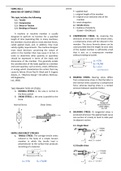Class notes
Machine Design
- Course
- Institution
- Book
This covers the fundamental principles and techniques used in the design of machine components. It is divided into several chapters that discuss various topics, such as the selection of materials, stress and strain analysis, fatigue, and shafts. This can be a useful reference for engineers and stu...
[Show more]



